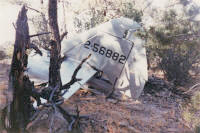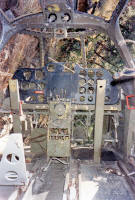|
Aircraft Wrecks in the Mountains and Deserts of the American West Curtiss AT-9A
On December 30, 1942 a USAAF Curtiss AT-9A #42-56882 was posted missing with a crew of two on board. The AT-9A had departed Demming, New Mexico assigned to conduct an aerial search for a USAAF Cessna AT-17 #42-113 that had been missing since December 26, 1942 with a crew of two. The AT-9A was piloted by Lt. Winston Bradford and Cadet Jerome Barleau who were searching the rugged mountains of the Gila National Forest when they flew into a box canyon from which there was no escape. Miraculously Lt. Bradford was able to effect a successful crash landing from which both men walked away with minor injuries. After hiking nearly ten miles Bradford and Barleau reached the safety of a ranch house. The AT-17 they had been searching for at the time of the accident was not located until November 19, 1942. Because the AT-9A crash site was difficult to reach, no salvage effort was under taken by the USAAF. In 1989 a retired USAF Chaplin, Lt. Col. Lawrence V. Tagg learned where the AT-9A wreck was located. Larry Tagg and his two sons, Philip, and Martyn began planning to recover the AT-9A by acquiring all of the necessary permits and permissions. Larry Tagg was highly motivated to save the wreck of the Curtiss “Jeep” because only one other example of this rare WWII advanced trainer remained in existence, and the U. S. Air Force has it. The Tagg Family mission was to facilitate the recovery of the AT-9A, but not to restore it. For the restoration aspect Larry contacted the Pima County Air Museum in Tucson, AZ. On May 6, 1993 the recovery mission was completed using a Bell/Textron 206L. A series of eight long line lifts brought the remains of the AT-9A to several flat bed trucks, and the uneventful drive to Tucson began. The Tagg Family had saved a rare and historic aircraft for preservation, and none to soon as a major forest fire burned through the crash site in 1995. 42-56882 remains in storage at the Pima County Air Museum today, awaiting restoration.
Special thanks
to Lawrence “Larry” V. Tagg for contacting me about this fine project in May
1992. His letters and photos have made this posting possible.
|
||||||
|
|
||||||




